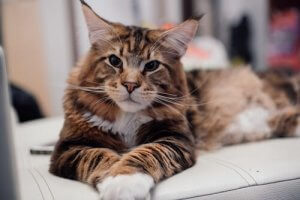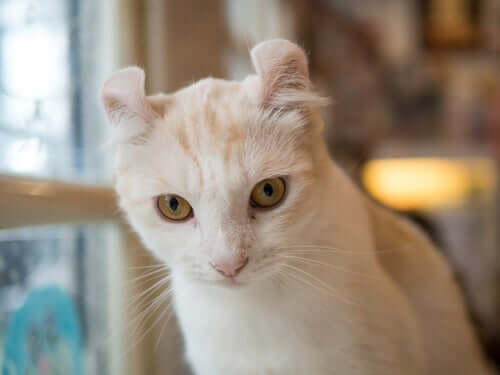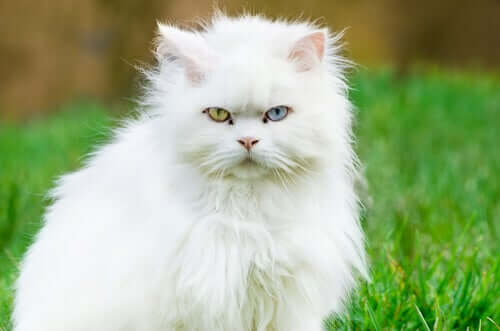Group II Cats from the FIFe Classification of Cat Breeds

The Fédération Internationale Féline is responsible for identifying and grouping cats according to their characteristics. In the following article, we’ll tell you what the group II cats from the FiFe classification are.
What are the group II cats?
A total of nine breeds belong to this group, and we’re going to highlight five of them:

1. American Curl
The FIFe distinguishes between long and short-haired American curls. The only differences between the two are their coats. That’s why we grouped them together. One of the main characteristics of the American Curl is the shape of its ears, as they curl back. Specimens are born with normal ears. However, since this cat breed’s cartilaginous tissue is very fragile, 10 days after being born, kittens’ ears start to deform.
It’s a medium-sized, strong cat with almost no genetic defects. The American Curl’s tail is as long as its body, and it can weigh up to 11 pounds (5 kilos). The eyes are well-separated and are yellow or green.
2. LaPerm
You can also find short-haired and long-haired LaPerms. This cat, that originated in America, has a curly coat, hence its name. Its tightest curls are at the base of its ears, throat, and belly. The coat is of different colors and patterns.
This breed of group II cats is very affectionate and isn’t related to any other cat, except for the Rex. It’s elegant and athletic, very active, extroverted, and doesn’t cause allergies like other cats. The LaPerm creators are from Oregon, United States, and the first specimen was called Curly. Its descendants are very similar to it, except for the coat color or length.
3. Maine Coon
This cat is also from the United States. According to legend, when Marie Antoinette wanted to escape from France, she embarked bound for North America with her Turkish Angora cats. Although the Queen didn’t make it, her cats did. They arrived at the town of Wiscasset, Maine (northeast of the country). A cabin boy named Tom Coon adopted them and made this breed after crossing the Turkish Angoras with local cats.
It’s a large cat, since males can weigh up to 24 pounds (11 kilos) and females up to 17 pounds (8 kilos). The Maine Coon has a medium-size head, prominent cheekbones, long, pointed ears, large and oval eyes, a muscular body, and a water-resistant coat of any color.
Regarding its temperament, the Maine Coon is quite loving and somewhat lazy, but agile enough to catch mice and other prey at the same time. The Maine Coon likes to be outdoors and in the company of other cats. It can meow with different tones. It eats a lot and some specimens suffer from obesity. This cat is very popular in its home country and in beauty pageants.

4. Turkish Angora
This is one of the oldest cat breeds that exists and it originated in the Turkish region of Ankara (the capital). Since they’re rarely found outside their country of origin, they weren’t crossed with other breeds, nor did they suffer alterations over time. The symbol of purity par excellence is the white coat and odd eye colors. There are also other coat colors: blue, red, brown, silver, cream, and tabby.
Regarding its temperament, the Turkish Angora is characterized by its intelligence, curiosity, agility, and hyperactivity. It usually meows a lot, prefers homes where only one or two people live, and is very peaceful and devoted to its owners (they follow them with their eyes all the time). The Turkish Angora loves being the center of attention and is very affectionate, polite, and perfect for an apartment in a city.
5. Siberian
This cat that belongs to the group II cats is native to northern Russia. It resulted from the crossing of a wild cat of the Siberian forests with a European cat. Its thick hair allows it to withstand the extreme temperatures of the area (which can reach -22°F). Kittens have short hair up until three months of age. They all have a tabby coat that they shed during the summer.
This cat is very friendly and playful, can weigh up to 19 pounds (9 kilos), is agile and fast, and is widely used for hunting rodents. The Siberian is remarkably intelligent and affectionate. Domestic male Siberians stay with females during delivery and the kittens’ first days.
The Fédération Internationale Féline is responsible for identifying and grouping cats according to their characteristics. In the following article, we’ll tell you what the group II cats from the FiFe classification are.
What are the group II cats?
A total of nine breeds belong to this group, and we’re going to highlight five of them:

1. American Curl
The FIFe distinguishes between long and short-haired American curls. The only differences between the two are their coats. That’s why we grouped them together. One of the main characteristics of the American Curl is the shape of its ears, as they curl back. Specimens are born with normal ears. However, since this cat breed’s cartilaginous tissue is very fragile, 10 days after being born, kittens’ ears start to deform.
It’s a medium-sized, strong cat with almost no genetic defects. The American Curl’s tail is as long as its body, and it can weigh up to 11 pounds (5 kilos). The eyes are well-separated and are yellow or green.
2. LaPerm
You can also find short-haired and long-haired LaPerms. This cat, that originated in America, has a curly coat, hence its name. Its tightest curls are at the base of its ears, throat, and belly. The coat is of different colors and patterns.
This breed of group II cats is very affectionate and isn’t related to any other cat, except for the Rex. It’s elegant and athletic, very active, extroverted, and doesn’t cause allergies like other cats. The LaPerm creators are from Oregon, United States, and the first specimen was called Curly. Its descendants are very similar to it, except for the coat color or length.
3. Maine Coon
This cat is also from the United States. According to legend, when Marie Antoinette wanted to escape from France, she embarked bound for North America with her Turkish Angora cats. Although the Queen didn’t make it, her cats did. They arrived at the town of Wiscasset, Maine (northeast of the country). A cabin boy named Tom Coon adopted them and made this breed after crossing the Turkish Angoras with local cats.
It’s a large cat, since males can weigh up to 24 pounds (11 kilos) and females up to 17 pounds (8 kilos). The Maine Coon has a medium-size head, prominent cheekbones, long, pointed ears, large and oval eyes, a muscular body, and a water-resistant coat of any color.
Regarding its temperament, the Maine Coon is quite loving and somewhat lazy, but agile enough to catch mice and other prey at the same time. The Maine Coon likes to be outdoors and in the company of other cats. It can meow with different tones. It eats a lot and some specimens suffer from obesity. This cat is very popular in its home country and in beauty pageants.

4. Turkish Angora
This is one of the oldest cat breeds that exists and it originated in the Turkish region of Ankara (the capital). Since they’re rarely found outside their country of origin, they weren’t crossed with other breeds, nor did they suffer alterations over time. The symbol of purity par excellence is the white coat and odd eye colors. There are also other coat colors: blue, red, brown, silver, cream, and tabby.
Regarding its temperament, the Turkish Angora is characterized by its intelligence, curiosity, agility, and hyperactivity. It usually meows a lot, prefers homes where only one or two people live, and is very peaceful and devoted to its owners (they follow them with their eyes all the time). The Turkish Angora loves being the center of attention and is very affectionate, polite, and perfect for an apartment in a city.
5. Siberian
This cat that belongs to the group II cats is native to northern Russia. It resulted from the crossing of a wild cat of the Siberian forests with a European cat. Its thick hair allows it to withstand the extreme temperatures of the area (which can reach -22°F). Kittens have short hair up until three months of age. They all have a tabby coat that they shed during the summer.
This cat is very friendly and playful, can weigh up to 19 pounds (9 kilos), is agile and fast, and is widely used for hunting rodents. The Siberian is remarkably intelligent and affectionate. Domestic male Siberians stay with females during delivery and the kittens’ first days.
This text is provided for informational purposes only and does not replace consultation with a professional. If in doubt, consult your specialist.








